The Beverage Can Seamers Market is estimated to be valued at USD 1.4 billion in 2025 and is projected to reach USD 2.2 billion by 2035, registering a compound annual growth rate (CAGR) of 4.5% over the forecast period.
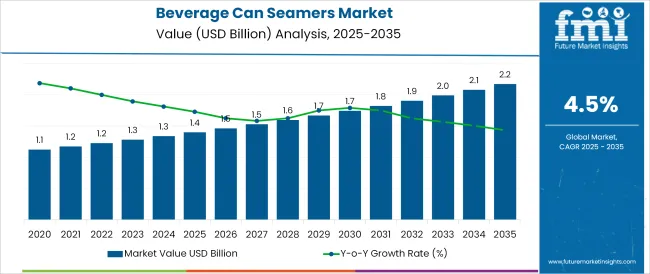
The beverage can seamers market is advancing steadily, supported by rising consumption of canned beverages, emphasis on packaging integrity, and growing automation across production lines. Manufacturers are prioritizing precision and speed in sealing processes to meet stringent food safety standards and reduce wastage.
Increasing demand for sustainable and recyclable packaging solutions has elevated the role of advanced seamers in ensuring can quality and minimizing material loss. Future market growth is expected to benefit from investments in high speed machinery, improved sealing technologies, and retrofitting of older production lines with modern automation.
The combination of regulatory scrutiny on packaging safety and operational efficiency imperatives is driving continuous innovation and adoption of advanced seaming equipment, paving the path for sustained market expansion.
The market is segmented by Design, Handle Attachment, Opening Type, Capacity, and End-use and region. By Design, the market is divided into Automatic, Semi-automatic, and Manual. In terms of Handle Attachment, the market is classified into Motor, Hand Crank, and Flywheel. Based on Opening Type, the market is segmented into Rotary, Non-Rotary, and Regular.
By Capacity, the market is divided into 500 to 750 ml, Up to 500 ml, 750 to 1000 ml, and Above 1000 ml. By End-use, the market is segmented into Non-alcoholic, Water, Soft Drinks, Juice & Juice Drinks, Others, Alcoholic, Beer, Cider, Wine, Spirits, Others, Café/Brew Drinks, Coffee, Hot Chocolate, Tea, and Others. Regionally, the market is classified into North America, Latin America, Western Europe, Eastern Europe, Balkan & Baltic Countries, Russia & Belarus, Central Asia, East Asia, South Asia & Pacific, and the Middle East & Africa.
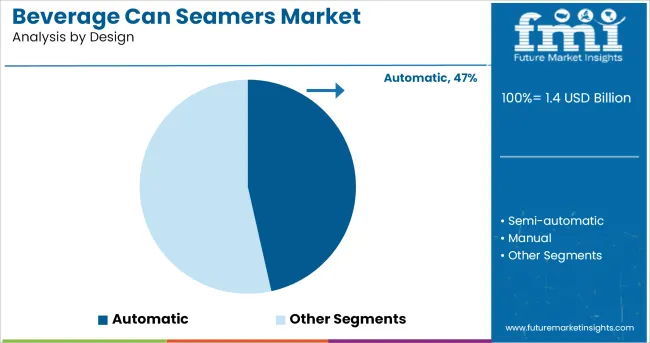
When segmented by design, the automatic segment is projected to capture 46.5% of the total market revenue in 2025, maintaining its leadership among design types. This dominance is attributed to the ability of automatic seamers to deliver higher throughput, consistent quality, and reduced dependency on manual intervention.
The integration of sensors, programmable logic controllers, and self-adjusting mechanisms has enhanced operational efficiency and minimized downtime. As production facilities increasingly adopt lean manufacturing principles, automatic designs have become essential for scaling operations while maintaining strict quality control.
Enhanced safety features and adaptability to different can sizes have further strengthened the position of automatic seamers, making them the preferred choice for high-volume beverage producers seeking to optimize productivity and compliance.
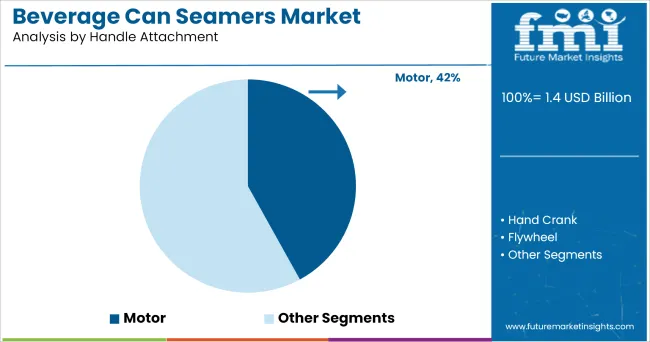
By handle attachment, the motor segment is expected to account for 42.0% of market revenue in 2025, positioning itself as the leading sub segment. This leadership has been shaped by the superior durability, power, and precision offered by motorized mechanisms, which are essential in maintaining seam integrity at high speeds.
The ability to sustain prolonged operations with minimal wear and tear has made motor-driven seamers indispensable in large-scale production settings. Their compatibility with modern automation systems and reduced maintenance requirements have reinforced their adoption across the industry.
Furthermore, advancements in energy-efficient motor technologies have aligned with sustainability initiatives while ensuring reliable performance, contributing to the sustained dominance of this segment.
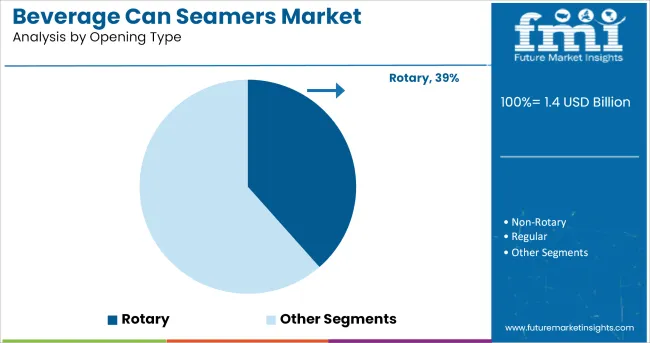
When segmented by opening type, the rotary segment is projected to hold 38.5% of total market revenue in 2025, affirming its position as the most prominent sub segment. This leadership stems from the rotary design’s capacity to handle high-speed operations while maintaining consistent seam quality.
The continuous motion provided by rotary systems allows for greater output and reduced cycle time, which are critical factors for beverage manufacturers operating under tight schedules and high demand.
Additionally, the compact footprint and ease of integration into existing production lines have bolstered its popularity. The ability of rotary seamers to accommodate diverse can formats and ensure precise sealing under dynamic conditions has further solidified their role as the preferred opening type in modern beverage canning operations.
Beverage cans demand is on the cusp of its growth. The demand for sustainable packaging and delivery of food and beverages is witnessing huge growth and is set to grow exponentially. So as the demand for can seamers is also launched on a positive note. Restaurants and bars are becoming a great opportunity for manufacturers as the purchases from the segment are anticipated to be doubled by the end of the assessment period.
Sales of beverage can seamers are set to behold high positivity, the market is nowhere to confront any alternatives as the product is the sole option for performing the operations required. The alternatives which may emerge in future will also remain the same with advancement and enhancement in its features.
The consistent demand for can seamers in industries remains tall standing opportunity for actors and is set to drop an insightful note for mutual development.
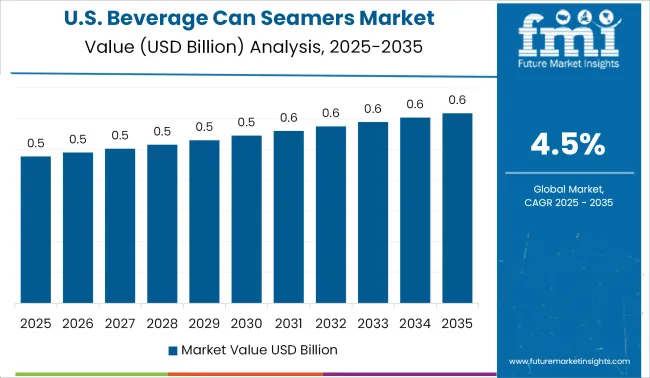
The United States is one of the most important markets for metal can packaging. The sale of beverage can sealers in the United States is expected to skyrocket between 2024 and 2035. The demand for recyclable packaging materials is on a high note, indicating that the market would experience enormous expansion in the next years facilitating the same for seamers' sales.
Canada is also one of the countries in the world that spends huge cash reserves on novel packaging technologies that are environmentally friendly and have a reliable filling and delivery system for beverages. The widespread adoption of cans for beverage packaging by large end-use industries is a favourable growth factor also driving the market for beverage can seamers.
All in all, as a result of these variables, North America has the most advantageous sources and is the most dominant globally.
Many EU countries have been severely impacted by COVID-19, resulting in a drop in economic activity. However, the region has made Greenfield and brownfield investments in sustainable food and beverage packaging solutions. The region has shown a strong desire to adopt metal beverage cans, with a particular interest in manual seamers.
In terms of beverage cans, nations such as Germany, France, Italy, Spain, the United Kingdom, Russia, and many others have given their approval for adaptation due to their multiple beneficial recyclability qualities thus resulted in huge market demand for beverage can sealers.

Major players present in the business of beverage can seamers market include
The majority of beverage can seamers leaders offer a diversified product line and high-quality packaging. Manufacturers choose to play with organic strategy by developing new production processes and other hybrid tactics to target a clientele and gain a competitive advantage over competitors.
The report is a compilation of first-hand information, qualitative and quantitative assessments by industry analysts, and inputs from industry experts and industry participants across the value chain. The report provides an in-depth analysis of parent market trends, macro-economic indicators and governing factors along with market attractiveness as per segments.
The report also maps the qualitative impact of various market factors on market segments and geographies.
The global beverage can seamers market is estimated to be valued at USD 1.4 billion in 2025.
The market size for the beverage can seamers market is projected to reach USD 2.2 billion by 2035.
The beverage can seamers market is expected to grow at a 4.5% CAGR between 2025 and 2035.
The key product types in beverage can seamers market are automatic, semi-automatic and manual.
In terms of handle attachment, motor segment to command 42.0% share in the beverage can seamers market in 2025.






Full Research Suite comprises of:
Market outlook & trends analysis
Interviews & case studies
Strategic recommendations
Vendor profiles & capabilities analysis
5-year forecasts
8 regions and 60+ country-level data splits
Market segment data splits
12 months of continuous data updates
DELIVERED AS:
PDF EXCEL ONLINE
Market Share Breakdown of Beverage Can Seamers Manufacturers
Beverage Packaging Market Size and Share Forecast Outlook 2025 to 2035
Beverage Carrier Market Size and Share Forecast Outlook 2025 to 2035
Beverage Cartoners Market Size and Share Forecast Outlook 2025 to 2035
Beverage Filter Paper Market Size and Share Forecast Outlook 2025 to 2035
Beverage Ingredients Market Analysis - Size and Share Forecast Outlook 2025 to 2035
Beverage Packaging Equipment Market Size and Share Forecast Outlook 2025 to 2035
Beverage Clouding Agent Market Size and Share Forecast Outlook 2025 to 2035
Beverage Packaging Machine Market Size and Share Forecast Outlook 2025 to 2035
Beverage Premix Market Size and Share Forecast Outlook 2025 to 2035
Beverage Acidulants Market Size and Share Forecast Outlook 2025 to 2035
Beverage Refrigeration Market Size and Share Forecast Outlook 2025 to 2035
Beverage Tester Market Size and Share Forecast Outlook 2025 to 2035
Beverage Dispenser Market Size and Share Forecast Outlook 2025 to 2035
Beverage Container Market Size and Share Forecast Outlook 2025 to 2035
Beverage Cups Market Size and Share Forecast Outlook 2025 to 2035
Beverage Stabilizer Market Growth, Trends, Share, 2025 to 2035
Beverage Emulsion Market Analysis - Size, Share, and Forecast Outlook 2025 to 2035
Beverage Crate Market Analysis – Size, Share, & Forecast Outlook 2025 to 2035
Beverage Flavoring Market Size, Growth, and Forecast for 2025 to 2035

Thank you!
You will receive an email from our Business Development Manager. Please be sure to check your SPAM/JUNK folder too.
Chat With
MaRIA